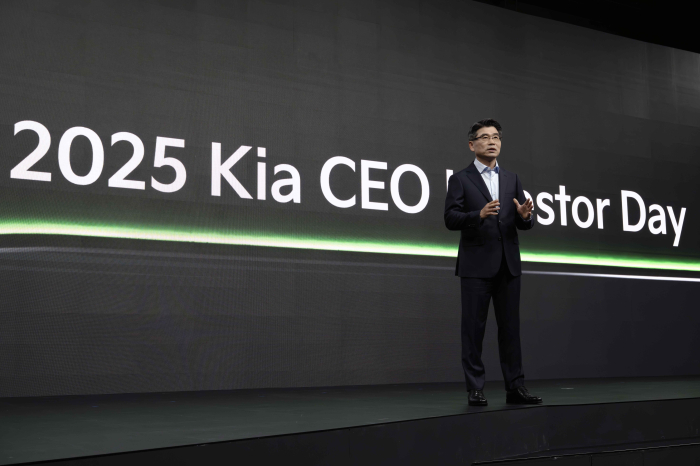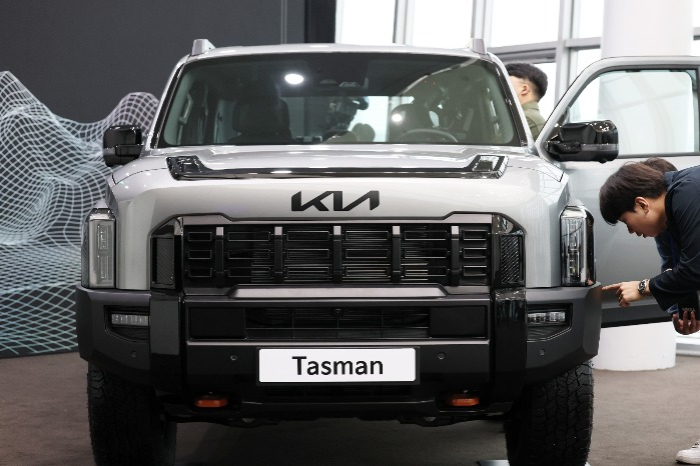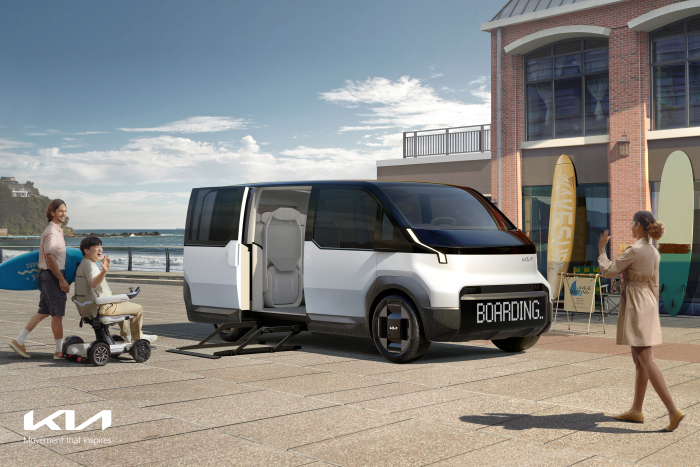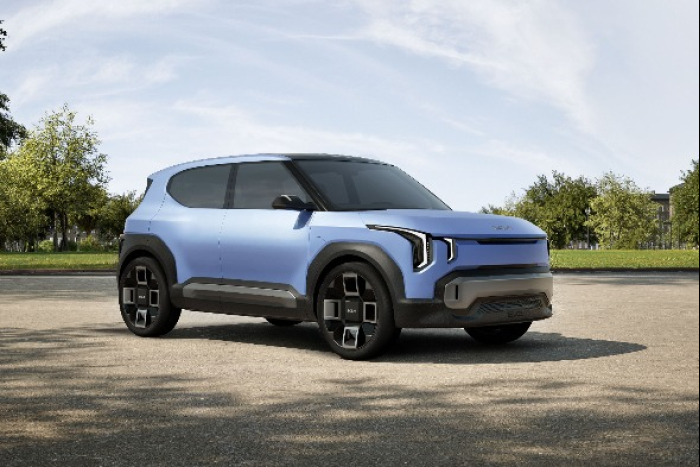Kia to build North America-targeted electric pickup model
The company will launch its first purpose-built vehicle model, the PV5, in July
By Apr 09, 2025 (Gmt+09:00)
LG Chem to sell water filter business to Glenwood PE for $692 million


Kyobo Life poised to buy Japan’s SBI Group-owned savings bank


KT&G eyes overseas M&A after rejecting activist fund's offer


StockX in merger talks with Naver’s online reseller Kream


Mirae Asset to be named Korea Post’s core real estate fund operator



Kia Corp., South Korea’s second-largest carmaker, will build an electric pickup model tailored for North America to enter the world’s largest pickup truck market, which it expects to offset the impact of the US tariff hikes, Chief Executive Song Ho-sung said on Wednesday.
The carmaker under Hyundai Motor Group will also foray into the purpose-built vehicle (PBV) market with the launch of the PV5 in July.
Kia is expanding its product lineup, bracing for a potential hit from Washington’s imposition of 25% reciprocal tariffs on imports from South Korea, which took effect on April 9.
During its 2025 CEO Investor Day, Song said a new pickup model for North America will be a mid-size electrified vehicle based on a next-generation EV platform. It targets a 7% share in the region's pickup truck market with annual sales of 90,000 units in the medium to long term.
The CEO said the upcoming pickup model tailored for North America will be differentiated from the Tasman unveiled in October. The Tasman is its first pickup truck with a 2.5-liter gasoline engine and targets Australia, South Korea and other emerging markets.

Kia’s electric pickup for North America will feature best-in-class cabin and cargo space, alongside advanced towing capabilities, according to Song.
It will also come with specialized driving features to enhance handling in off-road conditions, as well as class-leading safety systems and a next-generation infotainment platform.
PURPOSE-BUILT VEHICLES
To diversify its PBV models, Kia plans to roll out the PV7 in 2027 and the PV9 in 2029, following the launch of the PV5, a mid-size model, in July.
PBVs offer customizable interiors for various uses such as passenger transport, cargo delivery and mobility services for the transportation of the disadvantaged. Kia aims to sell 250,000 PBVs in 2030.

TARIFFS, FALLING DEMAND FROM CHINA
“We’ll begin realigning our manufacturing operations, directing as much output as possible from US plants to meet domestic demand,” Song added.
In 2025, Kia aims to sell 3.22 million units both at home and abroad. It plans to increase the figure to 3.75 million units by 2027 and 4.19 million units by 2030, according to the CEO.
However, the 2030 target is 2.6% lower than its previous projection released last year, which Song said reflects its more cautious outlook for the Chinese market.
“With the demand from China on the decline, we plan to utilize our Chinese factories as export hubs overseas to offset declining domestic sales in China,” he explained.

ECO-FRIENDLY MODELS
By 2030, Kia aims to bump up eco-friendly car shipments to 2.333 million units from this year’s target of 897,000 units. The 2030 sales projection for hybrid models is 21.7% higher than last year’s figure, while the 2030 target for EVs represented a 21.3% decrease compared to 2024.
Amid a protracted slowdown in EV demand, it is seeking to broaden the base of EV drivers by rolling out the EV2, its new entry-level electric sport utility vehicle, in 2026. It will join its EV lineup, including the EV3, EV4, EV5 and EV6.
Write to Bo-Hyung Kim and Jung-Eun Shin at kph21c@hankyung.com
Yeonhee Kim edited this article.
-
 AutomobilesKia to release PV9 in 2029, retains CEO for 3 more years
AutomobilesKia to release PV9 in 2029, retains CEO for 3 more yearsMar 14, 2025 (Gmt+09:00)
3 Min read -
 AutomobilesKia’s Chinese operations turn to profit after 8 years; Export strategy pays off
AutomobilesKia’s Chinese operations turn to profit after 8 years; Export strategy pays offMar 10, 2025 (Gmt+09:00)
3 Min read -
 Electric vehiclesHyundai, Kia ready to ramp up EV output in Europe, US
Electric vehiclesHyundai, Kia ready to ramp up EV output in Europe, USMar 06, 2025 (Gmt+09:00)
3 Min read -
 Electric vehiclesKia CEO stands firm on electrification strategy, premieres EV4 in Europe
Electric vehiclesKia CEO stands firm on electrification strategy, premieres EV4 in EuropeFeb 27, 2025 (Gmt+09:00)
4 Min read -
 EarningsKia hits record 2024 sales; profit margins highest among global automakers
EarningsKia hits record 2024 sales; profit margins highest among global automakersJan 24, 2025 (Gmt+09:00)
3 Min read -
 AutomobilesKia aims to reclaim Europe with EV2, keeps K4 output unchanged in Mexico
AutomobilesKia aims to reclaim Europe with EV2, keeps K4 output unchanged in MexicoDec 23, 2024 (Gmt+09:00)
4 Min read -
 Corporate strategyKia vows to drastically raise shareholder returns, hike EV, hybrid sales
Corporate strategyKia vows to drastically raise shareholder returns, hike EV, hybrid salesDec 04, 2024 (Gmt+09:00)
2 Min read -

-
 AutomobilesKia debuts Tasman to target $333 bn global pickup truck market
AutomobilesKia debuts Tasman to target $333 bn global pickup truck marketOct 29, 2024 (Gmt+09:00)
3 Min read -
 Electric vehiclesKia debuts all-electric EV6; runs faster, longer than Tesla, IONIQ 5
Electric vehiclesKia debuts all-electric EV6; runs faster, longer than Tesla, IONIQ 5Mar 30, 2021 (Gmt+09:00)
2 Min read -
 Korean innovators at CES 2024Kia to launch mid-sized purpose-built vehicle PV5 in 2025
Korean innovators at CES 2024Kia to launch mid-sized purpose-built vehicle PV5 in 2025Jan 09, 2024 (Gmt+09:00)
3 Min read


